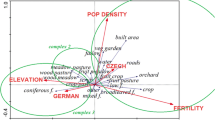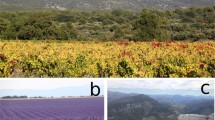Abstract
This paper overviews a variety of traditional agroforestry systems found in a small community of Filipino migrant farmers. Background information provides context, and then case studies of seven farmers are offered to illustrate the functions which their agroforestries fulfill in a situation of parcellization of farm-holdings into both level and sloping fields. The implications of the brief portraits presented for further research and development and for the acceptability of a social forestry program now going on in the community are suggested.
Similar content being viewed by others
References
Aguilar Jr FV (1982) Social Forestry for Upland Development: Lessons from Four Case Studies. Quezon City: Institute of Philippines Culture
Alicante MM et al (1938) Soil survey of Batangas Province, Philippine Islands. Soil report no. 4 of the Department of Agriculture and Commerce. Bureau of Printing, Manila
Alicante MM et al (1938) Soil survey of Rizal Province, Philippine Islands. Soil report no 2 of the Department of Agriculture and Commerce. Bureau of Printing, Manila
Braña Jr NA (1976) A study on the nutrition, management, and heat synchronization in carabaos and cattle in a milk collection area of Jala-jala, Rizal. M.Sc. (Animal Science) thesis, University of the Philippines at Los Baños
Burkill IH (1966) A Dictionary of the Economic Products of the Malay Peninsula, Vol I. Kuala Lumpur: Ministry of Agriculture and Cooperatives
Chambers R (1981) Rapid rural appraisal: rationale and repertoire. Public Administration and Development 1: 95–106
Conklin HC (1980) Ethnographic Atlas of Ifugao: A Study of Environment, Culture and Society in Northern Luzon. New Haven and London: Yale University Press
Filius AM (1982) Economic aspects of agroforestry. Agroforestry Systems 1 (1): 29–39
FAO-UNESCO (1976) Soil map of the world (1: 5 000 000): Volume IX and Sheet IX, South-east Asia, UNESCO, Paris
Merrill ED (1968) An Enumeration of Philippine Flowering Plants (4 vols). Amsterdam: A. Ascher (reprint)
Olofson H (1980) Swidden and Kaingin among the southern Tagalog: a problem in Philippine upland ethno-agriculture. Philippine Quarterly of Culture and Society 8 (2–3): 168–180
Olofson H (1980) An ancient social forestry (Review article of Harold C. Conklin's Ethnographic Atlas of Ifugao). Sylvatrop: The Philippine Forest Research Journal 5 (4): 255–262
Olofson H (1981) Mang Ruben and Mang Jeremias: permanent hillside farmers of Laguna. Philippine Quarterly of Culture and Society 9 (2): 111–134
Olofson H (1983) Indigenous agroforestry systems. Philippine Quarterly of Culture and Society 11 (3): 149–174
Raintree JB (1983) Strategies for enhancing the adoptability of agroforestry innovations. Agroforestry System 1 (3): 173–187
Author information
Authors and Affiliations
Rights and permissions
About this article
Cite this article
Olofson, H. Traditional agroforestry, parcel management, and social forestry development in a pioneer agricultural community: the case of Jala-jala, Rizal, Philippines. Agroforest Syst 3, 317–337 (1985). https://doi.org/10.1007/BF00055715
Issue Date:
DOI: https://doi.org/10.1007/BF00055715




